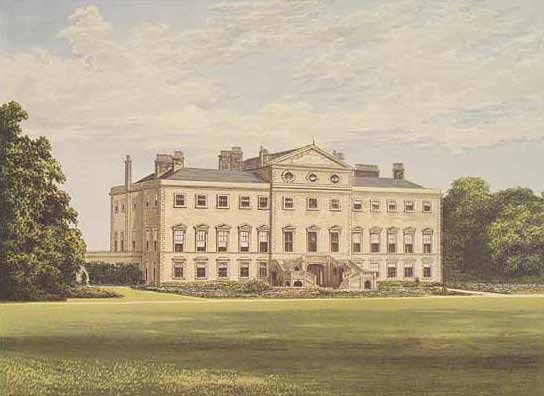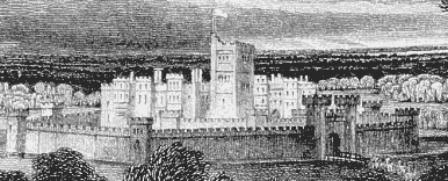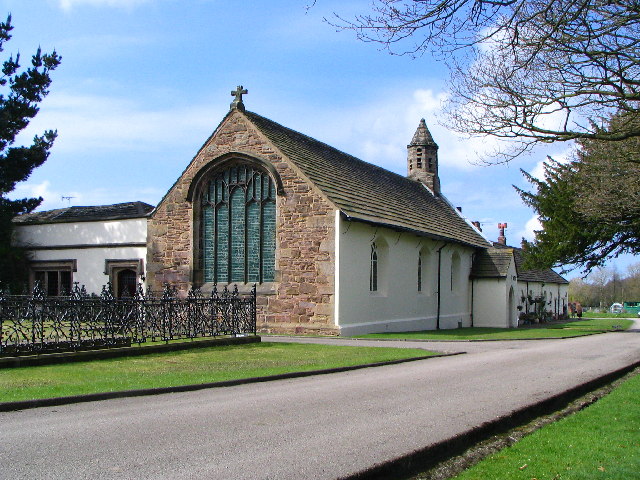|
Lathom House
Lathom House was a large country house in the parish of Lathom in Lancashire, England. Built between 1725 and 1740, the main block was demolished in 1925. Early history A wooden castle is believed to have stood on the site in mediaeval times. Sir John I Stanley of the Isle of Man (1350–1414), Lord Lieutenant of Ireland and King of Mann married Isabel Latham, daughter and heiress of Sir Thomas Latham of Latham. The stone-built castle known as Lathom House, built by the Audley-Stanley family, Stanley family in 1496, had eighteen towers, and was surrounded by a wall six foot thick and a moat eight yards wide, its drawbridge defended by a gateway tower. In the centre of the site was a tall tower known as the Eagle Tower. In 1554, Protestant martyr George Marsh (martyr), George Marsh, was questioned at Lathom House by Edward Stanley, 3rd Earl of Derby before being sent to Lancaster Castle. Lathom House was the last Royalist stronghold in Lancashire during the English Civil War a ... [...More Info...] [...Related Items...] OR: [Wikipedia] [Google] [Baidu] |
Lathom House From Morris's Country Seats 1880 Edited
Lathom is a village and civil parish in Lancashire, England, about 3 miles (5 km) northeast of Ormskirk. It is in the non-metropolitan district, district of West Lancashire, and with the parish of Newburgh, Lancashire, Newburgh forms part of Newburgh wards of the United Kingdom, ward. The population of the civil parish at the United Kingdom Census 2011, 2011 census was 914. The Leeds and Liverpool Canal passes through Lathom. History Toponymy Lathom was recorded as Latune in the Domesday Book in 1086, Lathum in 1200, and Lathom in 1223 after which it was the usual spelling. Manor In 1066 the manor of Lathom was the most important of 17 manors held by Uctred, an Anglo-Danish landowner. These manors were set up by Æthelstan in the 10th century. By 1189 Robert Fitzhenry de Lathom possessed lands throughout south Lancashire, extending to Flixton, Greater Manchester, Flixton in the barony of Manchester. Siward son of Dunning held the township in thanage in the reign of Henry I ... [...More Info...] [...Related Items...] OR: [Wikipedia] [Google] [Baidu] |
Thomas Fairfax, 3rd Lord Fairfax Of Cameron
Thomas Fairfax, 3rd Lord Fairfax of Cameron (17 January 161212 November 1671), also known as Sir Thomas Fairfax, was an English politician, general and Parliamentary commander-in-chief during the English Civil War. An adept and talented commander, Fairfax led Parliament to many victories, notably the crucial Battle of Naseby, becoming effectively military ruler of England, but was eventually overshadowed by his subordinate Oliver Cromwell, who was more politically adept and radical in action against Charles I. Fairfax became unhappy with Cromwell's policy and publicly refused to take part in Charles's show trial. Eventually he resigned, leaving Cromwell to control the country. Because of this, and also his honourable battlefield conduct and his active role in the Restoration of the monarchy after Cromwell's death, he was exempted from the retribution exacted on many other leaders of the revolution. Early life Thomas Fairfax was born at Denton Hall, halfway between Ilkley and Ot ... [...More Info...] [...Related Items...] OR: [Wikipedia] [Google] [Baidu] |
Liverpool (UK Parliament Constituency)
Liverpool was a borough constituency in the county of Lancashire of the House of Commons for the Parliament of England to 1706 then of the Parliament of Great Britain from 1707 to 1800 and of the Parliament of the United Kingdom from 1801 to 1885. It was represented by two Members of Parliament (MPs). In 1868, this was increased to three Members of Parliament. The borough franchise was held by the freemen of the borough. Each elector had as many votes as there were seats to be filled. Votes had to be cast by a spoken declaration, in public, at the hustings. In 1800 there were around 3000 electors, with elections in this seat being nearly always contested. The borough returned several notable Members of Parliament including Prime Minister George Canning, William Huskisson, President of the Board of Trade, Banastre Tarleton, noted soldier in the American War of Independence and most notably, William Roscoe the abolitionist and Anti Slave Trade campaigner. The constituency was ab ... [...More Info...] [...Related Items...] OR: [Wikipedia] [Google] [Baidu] |
Thomas Bootle
Sir Thomas Bootle (bapt. 16 May 1685 – 25 December 1753) was an English landowner and Member of Parliament. He was the eldest son of Robert Bootle of Maghull, Lancashire and studied law at Lincoln's Inn (1708) and the Inner Temple (1712) and was called to the bar in 1713. He served as King's attorney and serjeant within the Duchy of Lancaster from 1712 to 1727 and was created a KC by 1726. He succeeded his father in 1708 and bought the Lathom House estate at Lathom, near Skelmersdale, Lancashire. There he commissioned Giacomo Leoni to replace the existing house with the finest Palladian house in the county. Started in 1725 it was completed in 1740. He was elected Member of Parliament for Liverpool in 1724, sitting until 1734 and for Midhurst from 1734 to 1753. He was Mayor of Liverpool for 1726–27. He was attorney-general of the county palatine of Durham from 1733 to 1753. He was chancellor to Frederick, Prince of Wales in 1740–51 and to George, Prince of Wales from 175 ... [...More Info...] [...Related Items...] OR: [Wikipedia] [Google] [Baidu] |
John Ashburnham, 1st Earl Of Ashburnham
John Ashburnham, 1st Earl of Ashburnham (13 March 1687 – 10 March 1737) was a British Army officer and politician who sat in the House of Commons briefly in 1710 when he unexpectedly succeeded to the peerage and sat in the House of Lords. Early life Ashburnham was the second son of John Ashburnham, 1st Baron Ashburnham, and his wife, Bridget Vaughan, daughter of Walter Vaughan of Porthamel House, Brecon, South Wales, who had inherited Pembrey. In January 1707, he became a Guidon and major in the 1st Horse Guards through the efforts of his father. Career At the 1708 British general election Ashburnham stood for Rye where his father had an interest, but was unsuccessful. After his brother, William, inherited his father's barony of Ashburnham in 1709, he was returned in his place as Tory Member of Parliament for Hastings at a by-election on 10 February 1710. A few months later, his brother died childless, and he himself inherited the peerage. He gave up his seat in the House ... [...More Info...] [...Related Items...] OR: [Wikipedia] [Google] [Baidu] |
Henrietta Stanley, 4th Baroness Strange
Henrietta Maria Stanley, 4th Baroness Strange (1687 – 26 June 1718) was an English peer. Henrietta was born in 1687, the daughter of the 9th Earl of Derby. He died in 1709 and one of his titles, Baron Strange, fell into abeyance between Lady Henrietta and her younger sister Lady Elizabeth. On Lady Elizabeth's death in 1714 Henrietta became the sole heir and succeeded to the title. On 21 May 1706, she married the 4th Earl of Anglesey and so became the Countess of Anglesey. The Earl of Anglesey died in 1710. Henrietta then married the 3rd Baron Ashburnham (later created Earl of Ashburnham) on 24 July 1714 and became Lady Ashburnham. They had one child, also called Lady Henrietta, who succeeded her mother as Baroness Strange. The 4th Lady Strange died in 1718 and was buried at Ashburnham, East Sussex. Some years following her death, Parliamentary intervention was required to settle the ownership of the Bretherton estate which she had inherited. References *Cokayne, ... [...More Info...] [...Related Items...] OR: [Wikipedia] [Google] [Baidu] |
Restoration (England)
The Restoration of the Stuart monarchy in the kingdoms of England, Scotland and Ireland took place in 1660 when King Charles II returned from exile in continental Europe. The preceding period of the Protectorate and the civil wars came to be known as the Interregnum (1649–1660). The term ''Restoration'' is also used to describe the period of several years after, in which a new political settlement was established. It is very often used to cover the whole reign of King Charles II (1660–1685) and often the brief reign of his younger brother King James II (1685–1688). In certain contexts it may be used to cover the whole period of the later Stuart monarchs as far as the death of Queen Anne and the accession of the Hanoverian King George I in 1714. For example, Restoration comedy typically encompasses works written as late as 1710. The Protectorate After Richard Cromwell, Lord Protector from 1658 to 1659, ceded power to the Rump Parliament, Charles Fleetwood and John ... [...More Info...] [...Related Items...] OR: [Wikipedia] [Google] [Baidu] |
Lathom House West Wing
Lathom is a village and civil parish in Lancashire, England, about 3 miles (5 km) northeast of Ormskirk. It is in the district of West Lancashire, and with the parish of Newburgh forms part of Newburgh ward. The population of the civil parish at the 2011 census was 914. The Leeds and Liverpool Canal passes through Lathom. History Toponymy Lathom was recorded as Latune in the Domesday Book in 1086, Lathum in 1200, and Lathom in 1223 after which it was the usual spelling. Manor In 1066 the manor of Lathom was the most important of 17 manors held by Uctred, an Anglo-Danish landowner. These manors were set up by Æthelstan in the 10th century. By 1189 Robert Fitzhenry de Lathom possessed lands throughout south Lancashire, extending to Flixton in the barony of Manchester. Siward son of Dunning held the township in thanage in the reign of Henry II. Robert de Lathom, in the reign of Edward I was granted the right to hold a market and an annual fair. Robert Lathom founded Burs ... [...More Info...] [...Related Items...] OR: [Wikipedia] [Google] [Baidu] |
Roundhead
Roundheads were the supporters of the Parliament of England during the English Civil War (1642–1651). Also known as Parliamentarians, they fought against King Charles I of England and his supporters, known as the Cavaliers or Royalists, who claimed rule by absolute monarchy and the principle of the divine right of kings. The goal of the Roundheads was to give to Parliament the supreme control over executive administration of the country/kingdom. Beliefs Most Roundheads sought constitutional monarchy in place of the absolute monarchy sought by Charles; however, at the end of the English Civil War in 1649, public antipathy towards the king was high enough to allow republican leaders such as Oliver Cromwell to abolish the monarchy completely and establish the Commonwealth of England. The Roundhead commander-in-chief of the first Civil War, Thomas Fairfax, remained a supporter of constitutional monarchy, as did many other Roundhead leaders such as Edward Montagu, 2nd Earl of ... [...More Info...] [...Related Items...] OR: [Wikipedia] [Google] [Baidu] |
Bolton
Bolton (, locally ) is a large town in Greater Manchester in North West England, formerly a part of Lancashire. A former mill town, Bolton has been a production centre for textiles since Flemish people, Flemish weavers settled in the area in the 14th century, introducing a wool and cotton-weaving tradition. The urbanisation and development of the town largely coincided with the introduction of textile manufacture during the Industrial Revolution. Bolton was a 19th-century boomtown and, at its zenith in 1929, its 216 cotton mills and 26 bleaching and dyeing works made it one of the largest and most productive centres of Spinning (textiles), cotton spinning in the world. The British cotton industry declined sharply after the First World War and, by the 1980s, cotton manufacture had virtually ceased in Bolton. Close to the West Pennine Moors, Bolton is north-west of Manchester and lies between Manchester, Darwen, Blackburn, Chorley, Bury, Greater Manchester, Bury and ... [...More Info...] [...Related Items...] OR: [Wikipedia] [Google] [Baidu] |
James Stanley, 7th Earl Of Derby
James Stanley, 7th Earl of Derby, KG (31 January 160715 October 1651) was an English nobleman, politician, and supporter of the Royalist cause in the English Civil War. Before inheriting the title in 1642 he was known as Lord Strange. He was feudal Lord of the Isle of Man ("Lord of Man"), where he was known as "Yn Stanlagh Mooar" ("the Great Stanley"). Origins He was born at Knowsley, near Lathom House, on 31 January 1607, the eldest son of William Stanley, 6th Earl of Derby (1561–1642), KG, by his wife Elizabeth de Vere, a daughter of Edward de Vere, 17th Earl of Oxford. Early life After travelling abroad he was elected as a Member of Parliament for Liverpool in 1625. On 2 February 1626 he was created a Knight of the Bath on the coronation of King Charles I. 1626 he served jointly with his father as Lord Lieutenant of Lancashire, Lord Lieutenant of Cheshire and Chamberlain of the City of Chester. He assisted in the administration of the Isle of Man and in 1627 was appo ... [...More Info...] [...Related Items...] OR: [Wikipedia] [Google] [Baidu] |
Isle Of Man
) , anthem = "O Land of Our Birth" , image = Isle of Man by Sentinel-2.jpg , image_map = Europe-Isle_of_Man.svg , mapsize = , map_alt = Location of the Isle of Man in Europe , map_caption = Location of the Isle of Man (green) in Europe (dark grey) , subdivision_type = Sovereign state , subdivision_name = United Kingdom , established_title = Norse control , established_date = 9th century , established_title2 = Scottish control , established_date2 = 2 July 1266 , established_title3 = English control , established_date3 = 1399 , established_title4 = Revested into British Crown , established_date4 = 10 May 1765 , official_languages = , capital = Douglas , coordinates = , demonym = Manx; Manxman (plural, Manxmen); Manxwoman (plural, Manxwomen) , ethnic_groups = , ethnic_groups_year = 2021 , ethnic_groups_ref = Official census statistics provided by Statistics Isle of Man, Isle of Man Government: * * , religion = , religion_year = 2021 , relig ... [...More Info...] [...Related Items...] OR: [Wikipedia] [Google] [Baidu] |







